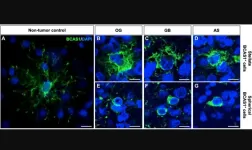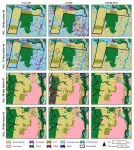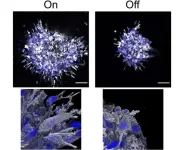(Press-News.org) Solar flares occur when magnetic energy builds up in the Sun’s atmosphere and is released as electromagnetic radiation. Lasting anywhere from a few minutes to a few hours, flares usually reach temperatures around 10 million degrees Kelvin. Because of their intense electromagnetic energy, solar flares can cause disruptions in radio communications, Earth-orbiting satellites and even result in blackouts.
Although flares have been classified based on the amount of energy they emit at their peak, there has not been significant study into differentiating flares based on the speed of energy build-up since slow-building flares were first discovered in the 1980s. In a new paper in Solar Physics, a team, led by UC San Diego astrophysics graduate student Aravind Bharathi Valluvan, has shown that there is a significant amount of slower-type flares worthy of further investigation.
The width-to-decay ratio of a flare is the time it takes to reach maximum intensity to the time it takes to dissipate its energy. Most commonly, flares spend more time dissipating than rising. In a 5-minute flare, it may take 1 minute to rise and 4 minutes to dissipate for a ratio of 1:4. In slow-building flares, that ratio may be 1:1, with 2.5 minutes to rise and 2.5 minutes to dissipate.
Valluvan was a student at the Indian Institute of Technology Bombay (IITB) when this work was conducted. Exploiting the increased capabilities of the Chandrayaan-2 solar orbiter, IITB researchers used the first three years of observed data to catalog nearly 1400 slow-rising flares — a dramatic increase over the roughly 100 that had been previously observed over the past four decades.
It was thought that solar flares were like the snap of a whip — quickly injecting energy before slowly dissipating. Now seeing slow-building flares in such high quantities may change that thinking.
“There is thrilling work to be done here,” stated Valluvan who now works in UC San Diego Professor of Astronomy and Astrophysics Steven Boggs’ group. “We’ve identified two different types of flares, but there may be more. And where do the processes differ? What makes them rise and fall at different rates? This is something we need to understand.”
END
The hottest catalog of the year: the most comprehensive list of slow-building solar flares yet
2024-01-31
ELSE PRESS RELEASES FROM THIS DATE:
Researchers uncover potential non-opioid treatment for chronic pain
2024-01-31
Among the most difficult types of pain to alleviate is neuropathic pain, pain that is usually caused by damage to nerves in various body tissues, including skin, muscle and joints. It can cause patients to suffer feelings like electric shocks, tingling, burning or stabbing. Diabetes, multiple sclerosis, chemotherapy drugs, injuries and amputations have all been associated with neuropathic pain, which is often chronic, sometimes unrelenting and affects millions of people worldwide. Many of the available pain medications are only moderately effective at treating this type of pain and often come with serious ...
John Theurer Cancer Center (JTCC) physician co-authors clinical research on innovative oral leukemia therapy
2024-01-31
Researchers at Hackensack Meridian’s John Theurer Cancer Center (JTCC), are part of a published Phase 3 study reporting on the equivalent safety and effectiveness in the oral treatment of blood cancers–such as myelodysplastic syndrome and/or chronic myelomonocytic leukemia–to its previously inpatient, intravenous treatment counterparts.
John Theurer Cancer Center is part of the NCI-designated Lombardi Comprehensive Cancer Center at Georgetown University.
Dr. James K. McCloskey, M.D., led JTCC’s ...
UC Irvine scientists make breakthrough in quantum materials research
2024-01-31
Irvine, Calif., Jan. 31, 2024 — Researchers at the University of California, Irvine and Los Alamos National Laboratory, publishing in the latest issue of Nature Communications, describe the discovery of a new method that transforms everyday materials like glass into materials scientists can use to make quantum computers.
“The materials we made are substances that exhibit unique electrical or quantum properties because of their specific atomic shapes or structures,” said Luis A. Jauregui, professor of physics & astronomy ...
BCAS1 defines a heterogeneous cell population in diffuse glioma patients
2024-01-31
“[...] this is the first study describing a BCAS1+ cell population in a large cohort of diffuse glioma patients.”
BUFFALO, NY- January 31, 2024 – A new research paper was published in Oncotarget's Volume 15 on January 24, 2024, entitled, “BCAS1 defines a heterogeneous cell population in diffuse gliomas.”
Oligodendrocyte precursor markers have become of great interest to identify new diagnostic and therapeutic targets for diffuse gliomas, since state-of-the-art studies point towards immature oligodendrocytes as a possible source of gliomagenesis. Brain enriched myelin associated ...
Microgreens made to order: Italian scientists have tailored iodine and potassium content of radishes, peas, rocket and chard
2024-01-31
In a significant development for personalised nutrition, researchers in Italy have cultivated microgreens with bespoke nutritional profiles to serve individual dietary requirements.
The study, published in the Journal of the Science of Food and Agriculture (doi: 10.1002/jsfa.13222), provides a blueprint for the soilless cultivation of nutritionally enriched plants in a commercial greenhouse setting.
Co-authors Massimiliano D’Imperio and Francesco Serio, both at the Institute of Sciences of Food Production (ISPA) National Council ...
How to make bright quantum dots even brighter
2024-01-31
Quantum dots are a kind of artificial atom: just a few nanometres in size and made of semiconductor materials, they can emit light of a specific colour or even single photons, which is important for quantum technologies. The discoverers and pioneers of the commercial production of quantum dots were awarded the Nobel Prize in Chemistry in 2023. In recent years, quantum dots made of perovskites have attracted particular attention. Perovskites belong to a class of materials that have a similar structure to the mineral perovskite ...
Method combines artificial intelligence and satellite imagery to map crop-livestock integration systems
2024-01-31
Crop-livestock integration (CLI) systems combine the growing of crops in rotation or consortium, especially grain crops such as soybeans, corn and sorghum, and forage plants used to feed cattle and pigs, with the raising of livestock, typically beef cattle. The crops provide most of the cash income, while the livestock has food available during the dry season and facilitates seed management. CLI improves soil fertility, raises yields and helps rehabilitate degraded areas while reducing the use of pesticides, mitigating the risk of erosion and the seasonality of production, and lowering ...
Pedestrian injuries from falls versus motor vehicle collisions: are we lacking critical policy and interventions?
2024-01-31
January 31, 2024—Using Emergency Medical Services (EMS) data, researchers at Columbia University Mailman School of Public Health compared the national burden of pedestrian injuries from motor vehicles to that of pedestrian falls occurring on streets and sidewalks and found that the probability of a pedestrian suffering a severe injury is higher for motor vehicle collisions as compared to falls. Yet, the public health burden of the number of pedestrians injured from a fall – severe or otherwise - is significantly higher compared to the number of pedestrians injured by a motor ...
Treatment of aggressive breast cancer: discovery of a new protein involved in the development of metastases
2024-01-31
A protein found abundantly in breast cancers that are refractory to conventional treatments is thought to cause the development of metastasis. Targeting it would prevent metastatic spread and therefore increase patients survival. These are the findings of a study conducted by a French-American team and led by a biologist at CNRS1. The study, the results of which appear on 31st January in Cell Discovery, aims to better understand the mechanisms at play in the development of primary tumours in aggressive ...
Worldwide prevalence and disability from mental disorders across childhood and adolescence
2024-01-31
About The Study: In this analysis using data from the 2019 Global Burden of Disease study, there was a high prevalence of mental disorders affecting children and youths, indicating that more than 1 of 10 (or 293 million) individuals ages 5 to 24 globally live with a diagnosable mental disorder. In terms of burden, around one-fifth of all disease-related disability (considering all causes) was attributable to mental disorders among this population. Additionally, this age period encompasses about one-fourth of the mental disorder burden across the entire life course.
Authors: Christian Kieling, M.D., Ph.D., of the Universidade ...





